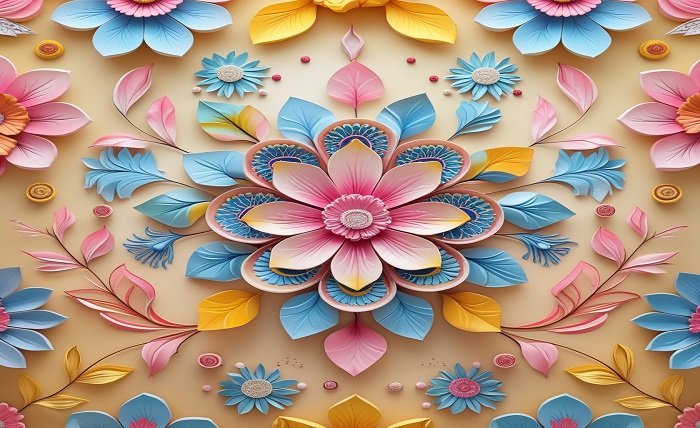A beloved art form in India, Rangoli combines artistic expression with tradition. A natural and environmentally sustainable choice that exudes beauty and aroma among its many forms is floral rangoli. Flower rangoli patterns are a popular option for contests, weddings, and festive celebrations because they are made with bright flower petals, leaves, and buds. With insights, advice, and ideas to help you create beautiful patterns, this blog delves into the intriguing world of flower rangoli designs.
Flower Rangoli’s Cultural Significance
flower rangoli designs has a special place in Indian culture because of its association with spirituality and the natural world. It is traditionally made to honor deities, greet guests, or commemorate auspicious occurrences. The use of flowers represents happiness, prosperity, and purity. An excellent option for modern festivities, this environmentally friendly art form also fits nicely with contemporary ecological practices.
Essential Components of Designs for Flower Rangoli
Creating a stunning flower rangoli designs requires a few key components:
Flower Selection: Because of their vivid hues and resilience, marigolds, roses, jasmine, lotuses, and daisies are well-liked options.
Color Harmony: Select a color scheme that goes well with the occasion and improves the overall design.
Patterns and Themes: Select a design pattern, such as floral motifs, geometric shapes, or cultural symbols.
Base Preparation: To keep the petals in place, make sure the surface is smooth and clean.
Layering Techniques: To provide depth and texture, carefully arrange the petals and leaves.
Customary Flower Rangoli Designs
Cultural heritage and symbolism are frequently reflected in traditional flower rangoli designs. Typical motifs include the following:
Lotus Designs: A common motif in rangoli, the lotus represents purity and divinity.
Peacock Patterns: Symbolizing grace and beauty, peacocks are a popular option for elaborate designs.
Geometric Patterns: Hexagons, triangles, and circles form symmetrical and eye-catching patterns.
Festival Symbols: Mango leaves for Pongal, kalash for pujas, and diyas for Diwali are common additions.
Innovative Ideas for Contemporary Flower Rangoli
Making your floral rangoli unique can be achieved by using contemporary themes. Here are a few suggestions:
Themes Inspired by Nature: Flower gardens, landscapes, and sunrises.
Festive Designs: patterns that use petals to spell Happy Diwali or Welcome.
Fusion Art: Combine international art forms, such as mandalas, with traditional Indian themes.
Social Messages: Draw attention to issues like women’s empowerment and environmental preservation.
Detailed Instructions for Creating a Flower Rangoli
To create a captivating flower rangoli designs, follow these steps:
Plan Your Design: Make a paper sketch of your design, paying attention to balance and symmetry.
Select Flowers: Select vibrantly colored, fresh flowers and separate the petals in advance.
Get the base ready: After cleaning the surface, use chalk or white powder to draw the outline.
Start with the Outline: To create a distinct shape, arrange the petals following the outline.
Fill the pattern: Add layers for depth by using petals, buds, and leaves to fill the pattern.
Add Details: Use tiny flowers, seeds, or diyas to accentuate the design.
Advice for Competitions in Flower Rangoli
It takes more planning and ingenuity to compete in a flower rangoli designs contest. Here are some pointers:
Recognize the Theme: Match the competition’s theme to your design.
Practice Beforehand: To guarantee flawless execution, practice your design.
Use Unusual Materials: Include unusual components such as fragrant flowers or colorful grains.
Put an emphasis on accuracy: neatness and focus on details can have a significant impact.
Time management: Finish the design in the allocated amount of time.
Eco-Friendly Flower Rangoli Substitutes
Eco-friendly techniques are naturally compatible with flower rangoli designs. To further increase its sustainability:
Use Locally Sourced Flowers: To lessen your carbon footprint, choose flowers that are grown nearby.
Compost the Leftovers: To reduce waste, compost was made from petals following the event.
Steer clear of plastic accessories: Remain with organic materials such as seeds, leaves, and stones.
Utilize Reusable Materials: Make use of biodegradable bases or clay diyas.
Adding Extra Elements to Flower Rangoli to Make It Better
Think about include the following components to enhance the beauty of your floral rangoli:
Candles and diyas: Light intensifies the hues of flowers.
Colored Sand or Powders: To create more contrast, mix rangoli powders with flowers.
Mirror Pieces: Tiny mirrors can create a glittering impression by reflecting light.
Aromatic Herbs: For a multisensory experience, incorporate aromatic herbs like lavender or basil.
Digital Display of Flower Rangoli
Presenting your flower rangoli online can increase its impact in the modern digital environment. Here’s how:
Photography Advice: For brilliant colors, take pictures of your rangoli in natural light.
Social Media Sharing: Post your artwork with imaginative captions on Facebook, Instagram, or Pinterest.
Time-Lapse Videos: To keep viewers interested, record your rangoli-making process.
Take Part in Online Contests: To reach a worldwide audience, enter virtual competitions.
Final Thoughts
flower rangoli designs are the perfect combination of art, custom, and nature. They provide countless opportunities for creativity, whether it be for competitions or holiday decorating. Beautiful designs that enthrall hearts and minds can be produced by fusing traditional patterns with contemporary topics and environmentally responsible techniques. Therefore, gather your petals, let your creativity run wild, and watch as your flower rangoli transforms into a painting.
FAQs
Which flowers work best for flower rangoli designs?
Because of their vivid hues and durability, lotuses, marigolds, roses, and jasmine are popular options.
How can I create an eco-friendly flower rangoli?
To ensure sustainability, use flowers that are grown nearby, compost leftovers, and stay away from plastic decorations.
What floral rangoli designs are suitable for beginners?
To begin, experiment with basic geometric designs, little flower motifs, or pre-made outlines.
How can I prolong the freshness of flower petals?
Petals can be refrigerated or stored in a cool, wet cloth until needed.
Is it possible to combine flowers and other elements in a rangoli?
Indeed, the design can be improved by incorporating flowers with colorful grains, sand, or diyas.
Allow your imagination to run wild and produce floral rangoli patterns that are memorable!
Read more about: toonstream

